Trees of the Adirondack Park
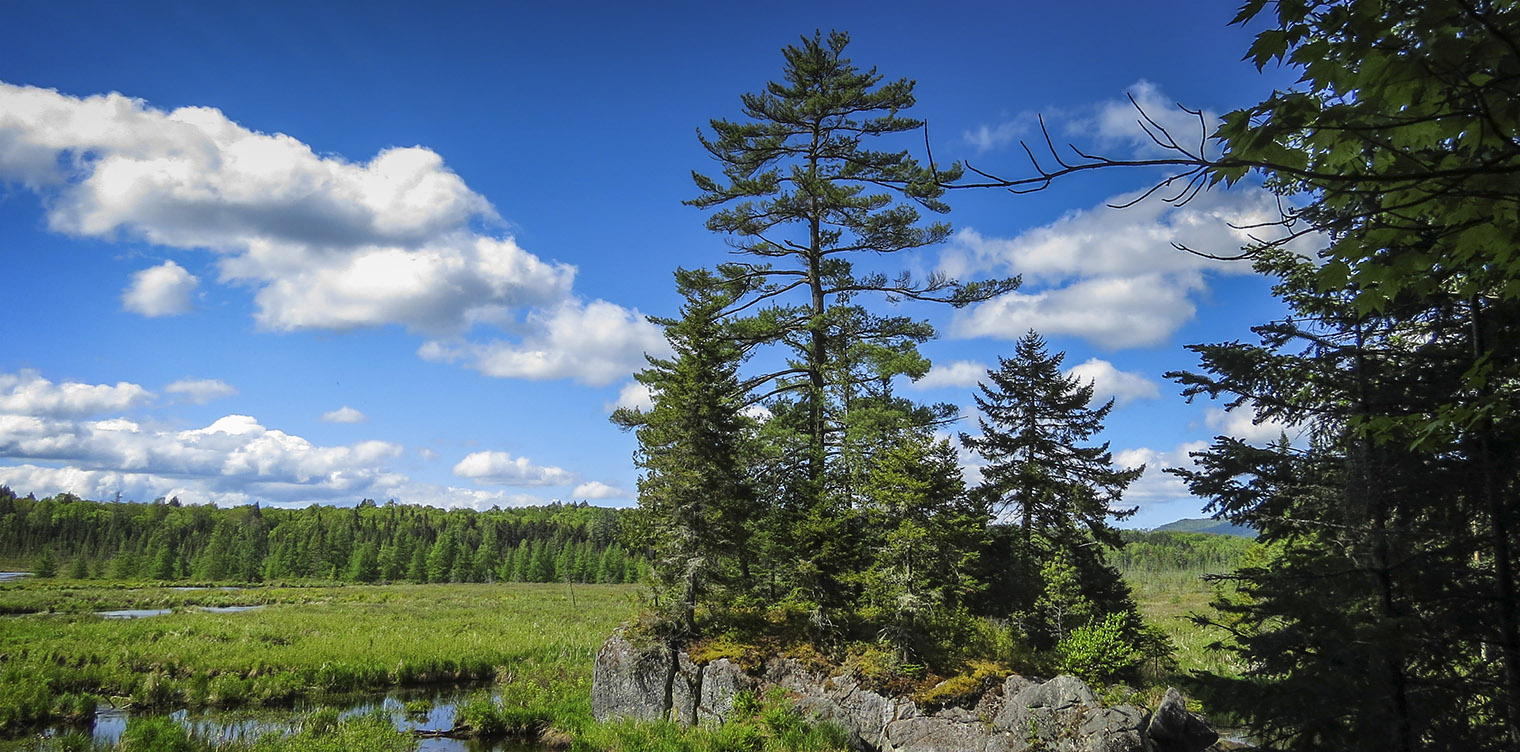
Sooner or later, most of us intrigued by the natural world come around to trees. It is difficult to understand and appreciate the interdependent elements of nature without an awareness of the role trees play in it. Trees provide cover, food, and homes for wildlife; they provide shade for the shrubs, wildflowers, ferns, and moss on the forest floor. They host mushrooms and insects. The decaying plant material from trees modifies the soil below. Trees, then, are a key component of the mosaic of living organisms that form the ecological communities that make up the Adirondacks.
Understanding that mosaic requires some study of trees. Even if your focus is on a different component of the natural world, knowing trees is critical.
- Birders, for instance, usually end up becoming botanizers because many birds have preferences, not just for general habitats, but in some cases for specific categories of trees or individual species. Knowing that the most likely place to find the Palm Warbler is on a bog, often perched on a Tamarack, is extremely helpful in finding and identifying that bird.
- Wildflower watchers know that certain plants are most often found under certain categories of trees or individual species, so that's where they look for them. Those in search of Squirrel Corn, for instance, would do well to look under Sugar Maples, because that's where they are usually found in our region.
Trees in Adirondack Forests: Strategies for Survival
Conifers and broad-leaved (deciduous) trees represent two different strategies for surviving and reproducing in the long harsh winters and short growing season of the mountains. Leaves are essential for photosynthesis, the process through which plants convert light energy into chemical energy. Both conifers and broad-leaved trees rely on their leaves to to convert water, carbon dioxide, and nutrients into energy that they can use to grow and reproduce.
Conifers of the Adirondack Park
- Balsam Fir (Abies balsamea)
- Black Spruce (Picea mariana)
- Eastern Hemlock (Tsuga canadensis)
- Eastern Redcedar (Juniperus virginiana)
- Eastern White Pine (Pinus strobus)
- Jack Pine (Pinus banksiana)
- Northern White Cedar (Thuja occidentalis)
- Norway Spruce (Picea abies)
- Pitch Pine (Pinus rigida)
- Red Pine (Pinus resinosa)
- Red Spruce (Picea rubens)
- Scotch Pine (Pinus sylvestris)
- White spruce (Picea glauca)
- Tamarack (Larix laricina)
Conifers are part of a larger category of plants called gymnosperms. The name derives from their reproductive strategy, which is is based on cones.
- With one exception in our area (the Tamarack), conifers hold onto their leaves all year round, which allows them to make a longer-term investment in tough leaves that can survive Adirondack winters.
- Needles are replaced slowly throughout the year, rather than all at once.
- Conifer leaves (either needle-like or scale-like) are compact to reduce water loss. To reduce water loss further when the air is cold and dry, conifers protect their leaves by growing a waxy coating.
- To deal with the weight of snow on their branches, most conifers are conical, so snow usually slides off.
From the standpoint of photosynthesis, evergreen leaves are not as efficient as as the leaves of hardwood species, but the evergreen leaf – because it lasts longer than a single season – makes more efficient use of nutrients from the soil. This strategy allows conifers to grow in sites with nutrient-deficient soils where broad-leaved trees cannot.
Hardwoods of the Adirondack Park
- American Basswood (Tilia americana)
- American Beech (Fagus grandifolia)
- American Elm (Ulmus americana)
- American Mountain Ash (Sorbus americana)
- Balsam Poplar (Populus balsamifera)
- Bigtooth Aspen (Populus grandidentata)
- Black Ash (Fraxinus nigra)
- Black Cherry (Prunus serotina)
- Pin Cherry (Prunus pensylvanica)
- Gray Birch (Betula populifolia)
- Hophornbeam (Ostrya virginiana)
- Mountain Maple (Acer spicatum)
- Northern Red Oak (Quercus rubra)
- Paper Birch (Betula papyrifera var.papyrifera)
- Quaking Aspen (Populus tremuloides)
- Red Maple (Acer rubrum)
- Serviceberry (Amelanchier arborea)
- Striped Maple (Acer pensylvanicum)
- Sugar Maple (Acer saccharum)
- White Ash (Fraxinus americana)
- Yellow Birch (Betula alleghaniensis)
Hardwoods (sometimes called broad-leaved or deciduous trees) take a different approach: annual leaf loss. These plants are part of a larger category called angiosperms. Like other angiosperms, broad-leaved plants are flowering plants.
- Hardwoods cope with winter by dropping their leaves at the end of the growing season. Most of the energy in the tree moves into its roots, reducing the tree's need for food, water, and growth. They then have to produce a new set of leaves in the spring.
- This strategy allows deciduous trees to put their resources into creating more leaf area, which is crucial since they can only photosynthesize during the months of the growing season.
These two strategies are part of the explanation for the complex pattern of trees we see in the different Adirondack habitats.
- Cone-bearing species have difficulty competing with hardwoods on the most desirable real estate (plant-wise). However, they are able to grow in sites with poor soils where broad-leaved trees (with more demanding soil and drainage requirements) cannot survive. The sites where conifers can survive, and even thrive, include saturated areas like wetlands and cold, wind-swept areas on the higher-elevations of mountains.
- Broad-leaved trees require better soils and a more congenial environment. However, in sites that meet their requirements, such as places with rich, well-drained soils in middle elevations (2500-4000 feet), broad-leaved trees are able to out-compete the conifers. This results in a northern hardwood forest dominated in the Adirondacks by Sugar Maple and American Beech.
- In between are flatter areas with less fertile and less well-drained soils than those occupied by the hardwoods. Here, the forests reflect the mix of conifers and hardwoods that we associate with the mixed wood forest.
Trees in Adirondack Forests: Pioneer and Climax Species
The trees that form the backbone of Adirondack forests can also be categorized in terms of their role in ecological succession.
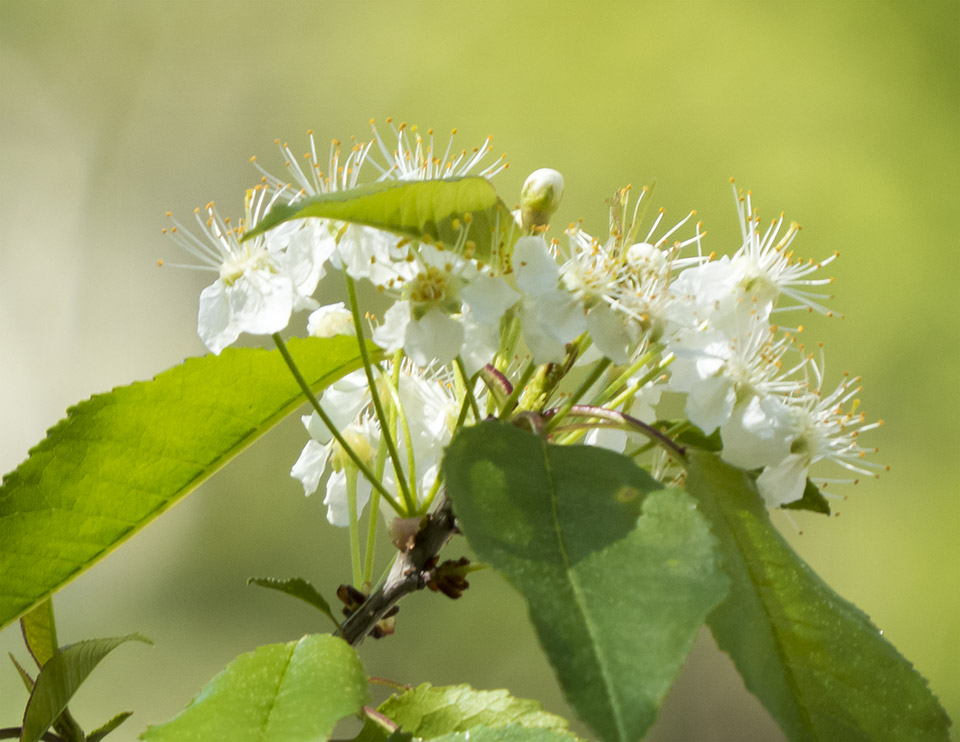
Pioneer (early successional) species are those trees able to colonize a previously disturbed site, thus beginning a chain of ecological succession. Some pioneers, like Paper Birch and Quaking Aspen, get a foothold in the new forest because they have light seeds that are carried by the wind far from the mother tree. The Pin Cherry (sometimes called the Fire Cherry because it rapidly colonizes burned areas) depends on birds to scatter its seeds through their droppings.
Pioneer species tend to be shade-intolerant species that need full sun. As they grow, the pioneers create a more shady environment adding organic matter to the soil, but also making the site unsuitable for their own seedlings.
Most pioneers are short-lived. The Pin Cherry, a fast-growing, shade-intolerant deciduous tree, lives only 25 to 30 years. The Paper Birch lives 60-80 years; the life span of Quaking Aspen trees (which reproduce by vegetative clones as well as by seed) is about the same. Bigtooth Aspen, another fast-growing pioneer species, can live a bit longer. Another fast-growing pioneer species which is shade-intolerant is Balsam Poplar, also generally short lived. However, the Eastern White Pine, a common invader of old fields, is an exception; it can live 300 to 350 years.
Mid-tolerant species, such as Yellow Birch and Black Cherry, take advantage of the conditions created by the pioneers to colonize the disturbed site. These trees are better adapted to shade and eventually shade out the original pioneer plants, taking over for decades until their canopy closes over the site. These trees are sometimes referred to as sub-climax trees.
Shade-tolerant species eventually take over, becoming dominant as the forest matures. Their seedlings can survive in the dense shade, growing slowly until openings in the canopy let in more sunlight and allow them to resume normal growth. Red Spruce and Eastern Hemlock are shade-tolerant conifers. American Beech and Sugar Maple are the most tolerant hardwood species in our area.
Tree Identification
Determining whether an individual tree is a conifer or a hardwood and whether it is flourishing in full sun or shade is just the first step in tree identification. About 100 native species of trees are present in the Adirondack Mountains. Many of these are found only on the lower elevations of the Adirondack Park. Only about thirty species can be found in the Adirondacks high peaks region. Identifying which species is represented by an individual tree draws on all five senses: sight, smell, hearing, taste, and touch, sight being the most important.
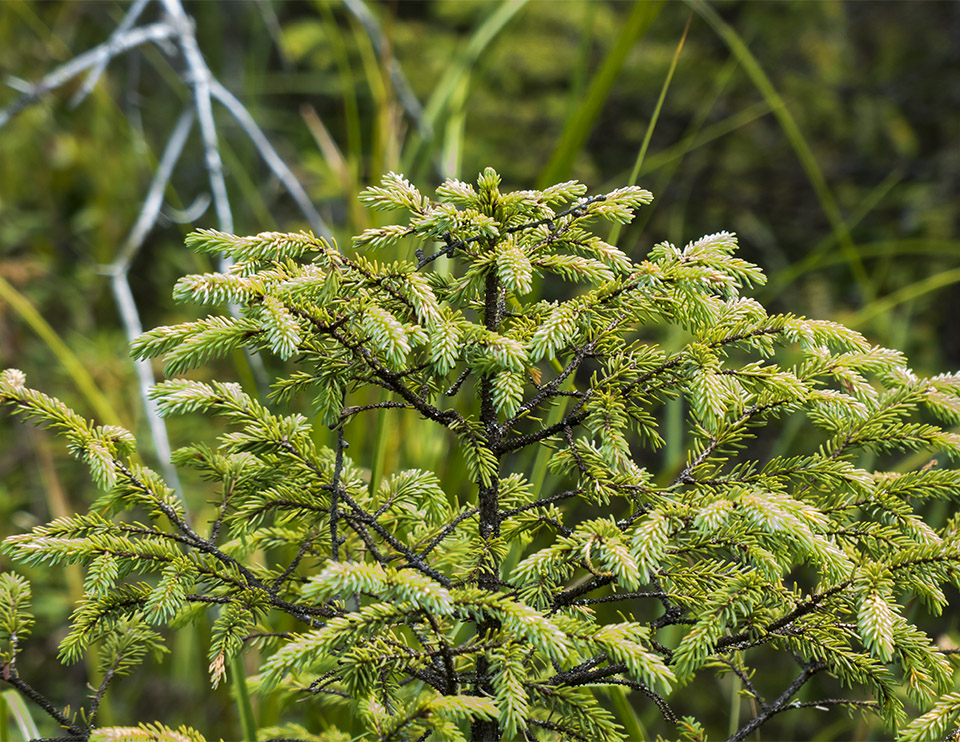
Where is it? Identifying the habitat is a relatively easy first step to identifying the tree. Elevation is key; the main habitats characteristic of the lower-elevation nature trails that are the focus here are northern hardwood forest, mixed wood forest, wetland (bog, fen, marsh, and swamp), and old field/successional forest. A good place to begin is at your feet. Look down.
- If the decaying plant material on the side of the trail consists of maple and beech leaves, you are probably in a northern hardwood forest.
- A mixture of needles and leaves is a clue to the mixed wood forest.
Some trees are generalists, which can survive (but perhaps not thrive) in a wide variety of soil and topographic conditions. Others, like the Black Spruce, are often to be found in certain habitats. For instance, if you find a spruce tree in the middle of a bog, you almost certainly have a Black Spruce, since Red Spruce generally do not grow there. Drainage, soil composition, and topography are other locational clues to tree species.
What do the leaves look like? Check out the shape, size, and color of the leaves or needles.
- For hardwood trees, leaf shape is a key identifier. The lobed leaves of maple trees are very different from the oval leaves of aspen. What does the leaf edge (or margin) look like? Smooth or toothed? Red Maple and Sugar Maple leaves have a similar shape, but the edges of the Sugar Maple leaf contrast with the double-toothed margins of the Red Maple.
- If the mystery tree is a conifer sporting needles, check out the arrangement, color, smell, and texture of the needles. If you have a cluster of five needles three to five inches long, blue green in color, soft and flexible to the touch, and whispering in the breeze, you probably have an Eastern White Pine. If the needles are short, appear to be arranged on a single plane, and feel soft and friendly to the touch, you probably have a Balsam Fir. If the foliage is scale-like, you can narrow it down to a few species that grow in our area (such as Northern White Cedar and Eastern Redcedar).
How are the leaves and branches arranged? If your target tree is a hardwood, check to see the leaf and branch arrangement.
- If the leaves appear singly at intervals along the twig (like your right arm and your left leg), you have a tree with alternate leaves.
- If the leaves emerge opposite one another (like your right arm and your left arm), you have a tree with opposite leaves. This narrows down the choice considerably, since the only trees with this arrangement in our area are maples, ash, and dogwood (acronym MAD).
In any event, it makes it much easier to look the tree up in field manuals based on leaf arrangement.
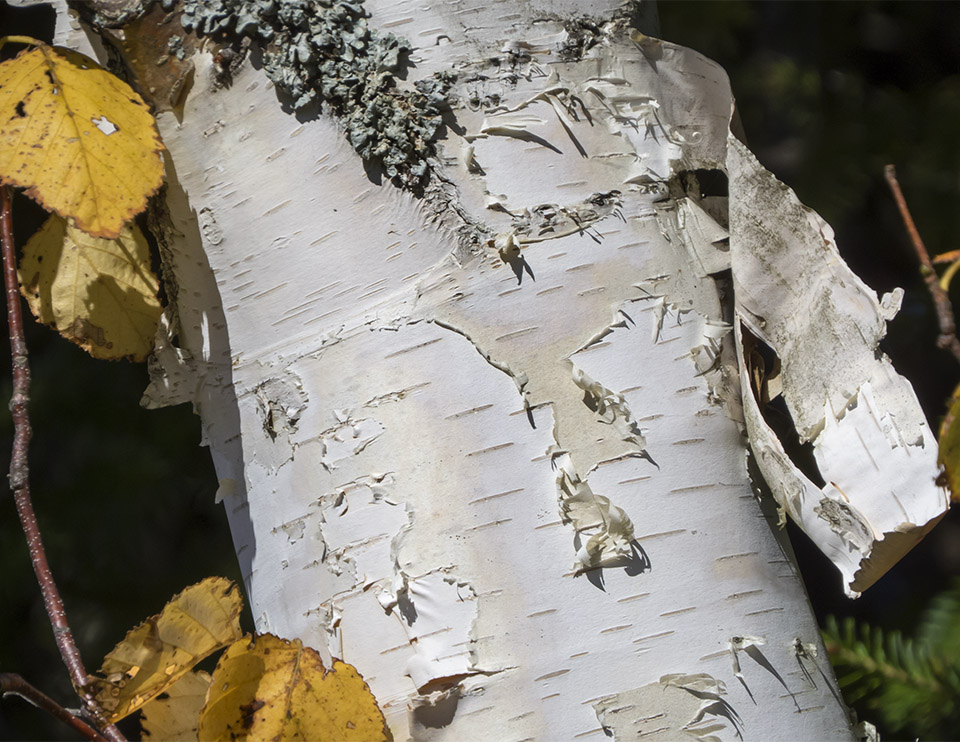
What does the bark look like? Bark can be tricky, because a lot of tree species have very similar bark. Even worse, bark changes over the life span of the tree, so the bark of a young tree may look very different from that of an older tree of the same species.
In some cases, however, bark is the main identification key. The distinctive peeling bark of birch trees is the main clue to distinguish them from other deciduous trees in the Adirondacks. The white bark and wide, thick strips of Paper Birches distinguish this species from the thin papery golden ringlets of Yellow Birch. If the bark has blisters that ooze a sticky aromatic resin when you poke them with a twig, you probably have a Balsam Fir.
How big is it? Some trees, such as the Striped Maple, rarely grow over twenty or thirty feet high, which means you can exclude them if you are looking at a tall canopy tree with lobed maple leaves under your feet. Pin Cherry leaves are similar to Black Cherry leaves, but Pin Cherry, a short-lived pioneer species, rarely grows over twenty feet tall, while Black Cherry can reach 75 feet.
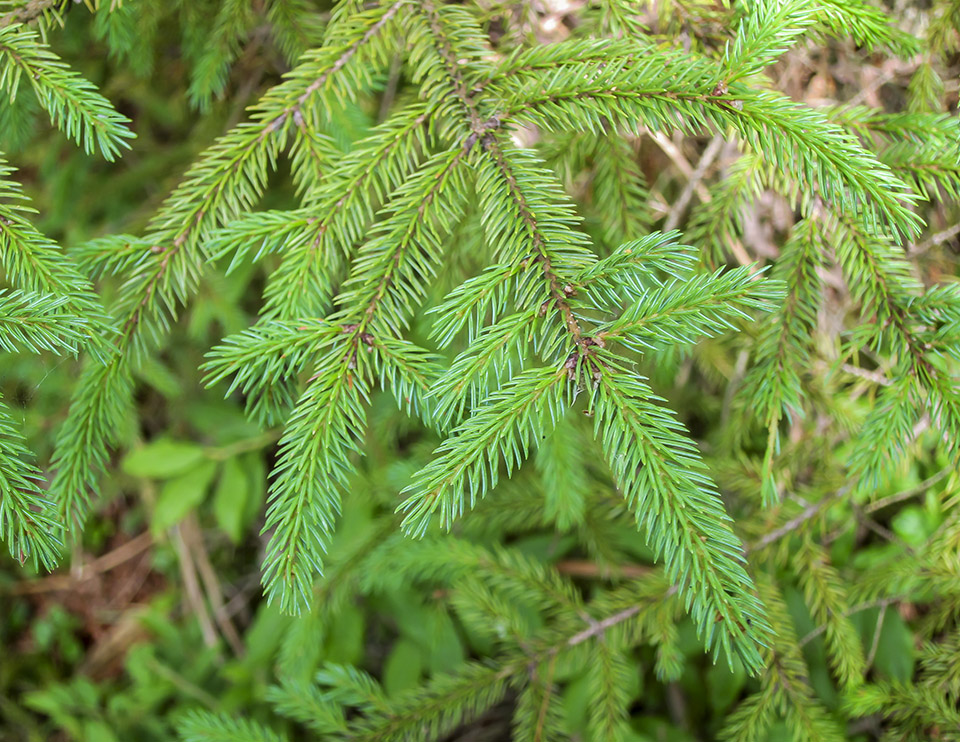
What does the tree smell like? Some similar species can be sorted out by using your nose.
- If your mystery tree is a birch, scrape a short section of its twig with your fingernail and give it a sniff. If the bark or needles smell like wintergreen, you probably have a Yellow Birch, rather than a Paper Birch.
- Odor can also help differentiate Red Spruce from White Spruce. The needles of the Red Spruce, when crushed, exude a fruity scent similar to that of orange rind. By contrast, crushing the needles of the White Spruce (sometimes known as the Cat Spruce or Skunk Spruce) produces a pungent odor evocative of cat urine or skunk.
- The crushed foliage and bark of Black Cherries have a distinctive cherry-like odor.
What do the cones look like? If your mystery tree is a conifer, examine the seed cones.
- The needles of Eastern Hemlock are similar to those of Balsam Fir, but their cones are very different. Eastern Hemlock cones are much smaller and pendant, while those of the Balsam Fir are upright.
- Cones also help to sort out the different species of pine that grow in the Adirondack Park. While there are many ways to differentiate the Red Pine from the Eastern White Pine, one of the easiest is by looking at the cones. Red Pine seed cones are short (1-2 inches) and round; Eastern White Pine cones are long (four to eight inches) and slender, with a pointed tip.
What does the tree silhouette look like? Some trees, when seen in open areas, can be distinguished by their shape. Shape can be particularly helpful for hardwood trees in winter, when the pattern of their branches can also be seen. Open-grown Sugar Maples, for instance, are generally oval in shape, with slender branches and fine twigs. Shape provides useful clues in relatively open areas, such as old fields. Unfortunately, tree shapes are not usually helpful to botanizers who study trees by walking forested trails, since trees assume a variety of shapes in the forest, depending on access to sunlight.
What season is it? Seasonal clues can be particularly helpful when trees are seen at a distance, especially in spring and fall. One of the first trees to leaf out is Quaking Aspen, whose lovely soft light green foliage provides a contrast to other trees when seen on hillsides in early spring. Red Maples produce distinctive small reddish pink flowers in late April to mid-May, giving the landscape a rosy glow. Tamaracks turn gold in late October after almost all hardwoods have dropped their leaves.
Adirondack Tree List
References
E.H. Ketchledge. Forests and Trees of the Adirondacks High Peaks Region (Adirondack Mountain Club, 1996).
Michael Kudish. Adirondack Upland Flora: An Ecological Perspective (Saranac, New York: The Chauncy Press, 1992).
Ellen Rathbone, "Adirondack Tree Identification 101," The Adirondack Almanack, 18 November 2009. Retrieved 31 January 2015.
Ellen Rathbone, "Adirondack Tree Identification 102," The Adirondack Almanack, 18 November 2009. Retrieved 31 January 2015.
Northern Forest Atlas. Images. Retrieved 4 February 2017.
Jerry Jenkins. Tree Branches 1. Sugar Maples. Northern Forest Atlas. Retrieved 4 February 2017.
John Kricher. A Field Guide to Eastern Forests. North America (Boston: Houghton Mifflin, 1998), pp. 154-219.
Peter J. Marchand. Nature Guide to the Northern Forest. Exploring the Ecology of the Forests of New York, New Hampshire, Vermont, and Maine (Appalachian Mountain Club, 2010), pp. 13-18, 56-93.
William K. Chapman and Alan E. Bessette. Trees and Shrubs of the Adirondacks: A Field Guide (Utica, New York: North Country Books, 1990).
Stan Tekiela. Trees of New York. Field Guide (Adventure Publications, 2006).
Donald D. Cox. A Naturalist's Guide to Wetland Plants. An Ecology for Eastern North America (Syracuse University Press, 2002).
George A. Petrides. A Field Guide to Eastern Trees (Boston: Houghton Mifflin Company, 1998).
George A. Petrides. A Field Guide to Trees and Shrubs (Boston: Houghton Mifflin Company, 1958,1972).
Gil Nelson, Christopher J. Earle, and Richard Spellenberg. Trees of Eastern North America (Princeton : Princeton University Press) .
C. Frank Brockman. Trees of North America (New York: St. Martin's Press).
Keith Rushforth and Charles Hollis. Field Guide to the Trees of North America (Washington, D.C., National Geographic, 2006).
National Audubon Society. Field Guide to North American Trees. Eastern Region. (New York: Alfred A. Knopf, 1980).
Alexander C. Martin, Herbert S. Zim, and Arnold L. Nelson. A Guide to Wildlife Food Habits (New York: Dover Publications, 1951).
Bruce Kershner, et al. National Wildlife Federation Field Guide to Trees of North America (New York: Sterling Publishing Co., 2008).
David Allen Sibley. The Sibley Guide to Trees (New York: Alfred A. Knopf, 2009).
Charles Fergus. Trees of Pennsylvania and the Northeast (Mechanicsburg, Pennsylvania: Stackpole Books, 2002).
Russell Burns and Barbara H. Honkala. Silvics of North America: Volume 1. Conifers (United States Department of Agriculture, Forest Service, 1990). Retrieved 22 March 2019.
Russell Burns and Barbara H. Honkala. Silvics of North America: Volume 2. Hardwoods (United States Department of Agriculture, Forest Service, 1990). Retrieved 22 March 2019.
Meiyin Wu and Dennis Kalma. Wetland Plants of the Adirondacks. Herbaceous Plants and Aquatic Plants (Trafford Publishing, 2010).
Ronald B. Davis. Bogs & Fens. A Guide to the Peatland Plants of the Northeastern United States and Adjacent Canada (University Press of New England, 2016), pp. 42-57.
John Eastman. The Book of Swamp and Bog: Trees, Shrubs, and Wildflowers of Eastern Freshwater Wetlands (Stackpole Books, 1995).
John Eastman. The Book of Forest and Thicket: Trees, Shrubs, and Wildflowers of Eastern North America (Stackpole Books, 1992).
John Eastman. The Book of Field and Roadside: Open-Country Weeds, Trees, and Wildflowers of Eastern North America (Stackpole Books, 2003).
Gary Wade et al. Vascular Plant Species of the Forest Ecology Research and Demonstration Area, Paul Smiths, New York. USDA Forest Service. Research Note NE-380. Retrieved 22 January 2017.
Mark J. Twery, at al. Changes in Abundance of Vascular Plants under Varying Silvicultural Systems at the Forest Ecosystem Research and Demonstration Area, Paul Smiths, New York. USDA Forest Service. Research Note NRS-169. Retrieved 22 January 2017.
Katherine Yard and Elizabeth Cooper. Young Forest Initiative Monitoring Plan. 2016 - 2025 (NYS Department of Environmental Conservation, 22 April 2016), Appendix A. Young Forest Wildlife. pp. 20-27.
Jeffrey S. Ward. Northeastern Forest Regeneration Handbook: A Guide for Forest Owners, Harvesting Practitioners, and Public Officials. USDA Forest Service. NA–TP–03–06 July 2006. Retrieved 22 March 2019.
New York State. Adirondack Park Agency. Natural Communities of the Adirondack Park. Retrieved 13 January 2017.
New York State Department of Environmental Conservation. New York Natural Heritage Program. Ecological Communities of New York State. Second Edition (March 2014). Retrieved 17 January 2017.
New York Natural Heritage Program. 2019. Online Conservation Guide for Beech-Maple Mesic Forest. Retrieved 22 March 2019.
New York Natural Heritage Program. 2019. Online Conservation Guide for Black Spruce-Tamarack Bog. Retrieved 22 March 2019.
New York Natural Heritage Program. 2019. Online Conservation Guide for Boreal Heath Barrens. Retrieved 22 March 2019.
New York Natural Heritage Program. 2019. Online Conservation Guide for Dwarf Shrub Bog. Retrieved 22 March 2019.
New York Natural Heritage Program. 2019. Online Conservation Guide for Hemlock-Hardwood Swamp. Retrieved 22 March 2019.
New York Natural Heritage Program. 2019. Online Conservation Guide for Hemlock-Northern Hardwood Forest. Retrieved 22 March 2019.
New York Natural Heritage Program. 2019. Online Conservation Guide for Inland Poor Fen. Retrieved 22 March 2019.
New York Natural Heritage Program. 2019. Online Conservation Guide for Northern White Cedar Swamp. Retrieved 22 March 2019.
New York Natural Heritage Program. 2019. Online Conservation Guide for Patterned Peatland. Retrieved 22 March 2019.
New York Natural Heritage Program. 2019. Online Conservation Guide for Pine-Northern Hardwood Forest. Retrieved 22 March 2019.
New York Natural Heritage Program. 2019. Online Conservation Guide for Rich Hemlock-Hardwood Peat Swamp. Retrieved 22 March 2019.
New York Natural Heritage Program. 2019. Online Conservation Guide for Shallow Emergent Marsh. Retrieved 22 March 2019.
New York Natural Heritage Program. 2019. Online Conservation Guide for Shrub Swamp. Retrieved 22 March 2019.
New York Natural Heritage Program. 2019. Online Conservation Guide for Spruce-Fir Swamp. Retrieved 22 March 2019.
New York State. Department of Environmental Conservation. Strategic Plan for State Forest Management. 2011. Chapter 2, pp. 46-52. Retrieved 27 January 2017.
New York State Forest Resource Assessment and Strategy: 2010 – 2015 Keeping New York’s Forests as Forests (New York State. Department of Environmental Conservation, 2010), pp. 24-30.
